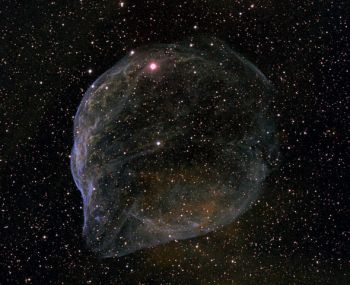 Wolf-Rayet stars lead short, violent lives. They’re so bright that pressure from light itself can blow material off the surface, leading to string winds of gas blasting out from the star. Some time ago, EZ CMa blew out just such a wind, which expanded away from the star in a roughly-spherical manner. It slammed into the gas floating in between the stars, sweeping it up and heating it, creating that magnificent bubble. The gas cloud itself is called Sharpless 2-308.
Wolf-Rayet stars lead short, violent lives. They’re so bright that pressure from light itself can blow material off the surface, leading to string winds of gas blasting out from the star. Some time ago, EZ CMa blew out just such a wind, which expanded away from the star in a roughly-spherical manner. It slammed into the gas floating in between the stars, sweeping it up and heating it, creating that magnificent bubble. The gas cloud itself is called Sharpless 2-308.
It’s when I look at the numbers that this starts to make my brain tingle. The distance to EZ CMa is difficult to determine, but it’s most likely about 5000 light years away. Even from that stunning distance — that’s 50 quadrillion kilometers (30 quadrillion miles) — the star is almost bright enough to be seen with the naked eye. If the Sun were that far away, you’d need a pretty good telescope to see it at all.

